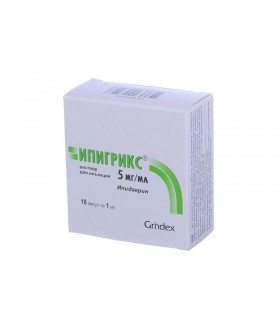




Security policy (edit with Customer reassurance module)

Delivery policy (edit with Customer reassurance module)

Return policy (edit with Customer reassurance module)
Release form
solution for intramuscular and subcutaneous administration.
Packaging
10 ampoules
Pharmacotherapeutic group: Anticholinesterase agents.
Pharmacological properties
Pharmacodynamics
Ipidacrine is a reversible inhibitor of cholinesterase. It directly stimulates the conduction of impulses in the central nervous system (CNS) and neuromuscular synapses, blocking the potassium channels of the membranes. Enhances the effect on smooth muscles not only of the mediator acetylcholine, but also of adrenaline, serotonin, histamine and oxytocin.
Main pharmacological effects of ipidacrine:
- restoration and stimulation of neuromuscular conduction;
- restoration of impulse conduction in the peripheral nervous system after blockade caused by certain factors (for example, trauma, inflammation, the action of local anesthetics, antibiotics, toxins and potassium chloride);
- increased contractility and tone of the smooth muscles of the internal organs;
- specific moderate stimulation of the CNS in combination with individual manifestations of the sedative effect;
- memory improvement.
In preclinical studies, ipidacrine had no teratogenic, embryotoxic, mutagenic, carcinogenic, and immunotoxic effects, and did not affect the endocrine system.
Sufficient data from clinical studies of the safety of ipidacrine in children are not available.
Pharmacokinetics
Absorption
After oral administration, ipidacrine is rapidly absorbed from the gastrointestinal tract. The maximum concentration in plasma after subcutaneous or intramuscular administration is achieved within 25-30 minutes. About 40-55% of the active substance is bound to plasma proteins. The therapeutic effect appears 15–20 minutes after parenteral administration. The duration of the drug is 3-5 hours.
Distribution
The drug penetrates the blood-brain barrier. Ipidacrine rapidly enters the tissue, only 2% of the drug is found in the plasma in an equilibrium state.
Metabolism and excretion
The drug is metabolized in the liver. Ipidacrine excretion is renal and extrarenal (through the gastrointestinal tract), excretion in the urine prevails. The half-life of ipidacrine is 40 min. After parenteral administration, 34.8% of the applied dose of ipidacrine is excreted unchanged in the urine. This indicates a rapid metabolism of the drug in the body.
- Diseases of the peripheral nervous system (neuritis, polyneuritis, polyneuropathy, polyradiculopathy, myasthenia gravis and myasthenic syndrome of various etiologies).
- Diseases of the central nervous system: bulbar paralysis and paresis.
- Period of recovery after organic lesions of the central nervous system, accompanied by motor impairment.
With caution in: gastric ulcer and duodenal ulcer, thyrotoxicosis, diseases of the cardiovascular system, as well as patients with obstructive diseases of the respiratory system in history or in acute diseases of the respiratory tract.
Ipidacrine enhances the tone of the uterus and can cause premature labor, therefore it is contraindicated during pregnancy. The use of ipidacrine during breastfeeding is contraindicated.
Influence on ability to drive vehicles and work with mechanisms
Ipidacrine may have a sedative effect, so patients exposed to this effect when using the drug, should be careful when driving and working with mechanisms
Precautions for use
There are no systematic data on the use of children.
At the time of treatment should be excluded alcohol, which increases the side effects of ipidacrine.
Ipidacrine can aggravate the course of epilepsy, as well as increase the negative effect of alcohol on the body.
In patients with depression, ipidacrine may increase the symptoms of depression.
In connection with the possible risk of bradycardia when using ipidacrine, cardiac activity should be monitored.
1 ml of solution contains:
active ingredient: ipidacrine hydrochloride monohydrate - 5.4 mg or 16.2 mg (in terms of ipidacrine hydrochloride - 5.0 mg or 15.0 mg);
excipients: 1 M hydrochloric acid solution to a pH of 2.8-4.0, water for injection to 1 ml.
Description
Transparent colorless liquid.
Intramuscular or subcutaneous.
Doses and duration of treatment are determined individually depending on the severity of the disease.
Peripheral nervous system diseases
Diseases of the central nervous system
Ipidacrine is usually well tolerated. Side effects are mainly associated with stimulation of m-cholinergic receptors.
The following side effects of ipidacrine are classified into groups of systems and organs, indicating the frequency of occurrence: often (≥1 / 100 to <1/10), infrequently (≥1 / 1000 to <1/100), rarely (≥1 / 10 000 to < 1/1000)
Disorders of the gastrointestinal tract
Often: hypersalivation, nausea.
Infrequently: vomiting.
Rarely: diarrhea, epigastric pain.
Unknown: dyspepsia.
Nervous system disorders
Infrequently: dizziness, headaches, drowsiness, muscle spasm, weakness.
Impaired cardiac function
Often: heartbeat, bradycardia.
Violations of the organs of sight
Unknown: miosis.
Disorders of the respiratory system, chest and mediastinum
Infrequently: increase in bronchial secretion, bronchospasm.
Disorders of the musculoskeletal system and connective tissue
Unknown: tremor, convulsions, increasing the tone of the uterus.
Violations of the skin and subcutaneous tissues
Often: sweating.
Infrequently: allergic reactions (itching, rash), usually when using large doses of the drug.
General disorders and reactions at the site of administration
Unknown: hypothermia, chest pain, jaundice.
If these side effects appear, or if a side effect occurs that is not mentioned in the instructions, you should consult a doctor.
Ipidacrine reduces the inhibitory effect on the neuromuscular transmission and conduction of excitation along the peripheral nerves of local anesthetics, aminoglycosides and potassium chloride.
The sedative effect of drugs that inhibit the central nervous system, including ethanol, as well as the effect of other cholinesterase inhibitors and m-cholinomimetic substances under the influence of ipidacrine is enhanced.
With the simultaneous use of other cholinergic drugs ipidacrine increases the risk of a cholinergic crisis in patients with myasthenia.
Beta-adrenolytic agents increase the severity of bradycardia caused by ipidacrine.
Cerebrolysin potentiates the effect of ipidacrine.
Alcohol increases the unwanted side effects of ipidacrine.
Overdose
Symptoms of severe overdose may develop a cholinergic crisis (loss of appetite, bronchial spasm, lacrimation, sweating, pupillary constriction, nystagmus, enhanced motility of the gastrointestinal tract, spontaneous defecation and urination, vomiting, jaundice, bradycardia, a violation of intracardiac conduction, arrhythmia, arterial hypotension, anxiety, anxiety, agitation, fear, ataxia, convulsions, coma, speech disorder, drowsiness, general weakness).
Treatment: carry out symptomatic therapy, apply m-anticholinergic substances (including atropine, cyclodol, metacin).
Store at a temperature not higher than 25aboutC. Do not freeze!